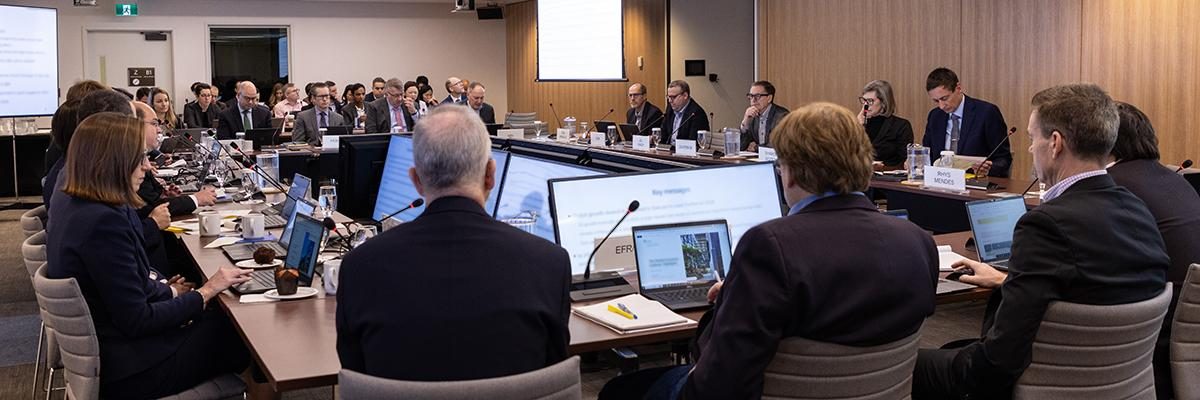
The monetary policy decision-making process
One of the Bank of Canada’s core objectives is to keep inflation low, stable and predictable. The Bank implements monetary policy to achieve this objective. More specifically, it uses its policy interest rate to control inflation.
On eight fixed dates per year, the Bank announces its decision for the policy interest rate. Before each decision, Governing Council must reach a consensus on whether to move the Bank’s policy interest rate up or down or keep it the same.
The main participants in the Bank’s process include its:
- Governing Council, which is responsible for making the decision
- Monetary Policy Review Committee (MPRC), composed of Governing Council members and select senior Bank leaders who discuss the challenges and merits of different courses of action
- four economics departments, which produce the forecasts and other analyses that feed into the process
The Bank’s monetary policy decision-making process is driven by data, highly collaborative and punctuated by critical milestones. Governing Council considers the challenges from many angles, drawing from diverse perspectives and the full breadth of staff expertise. The process enables Governing Council to methodically hone its focus on the information that matters most, ensuring the Bank can act with confidence in the best interests of Canadians.
Starting with the big picture
At the outset of the decision-making process, the MPRC takes a broad view. Members draw insights from various sources of information, which gives them a comprehensive view of the current state of the economy and how it is most likely to evolve. Two key inputs are included:
- The staff projection focuses on forecasts. Staff combine outputs from the Bank’s economic models with other key data to produce different scenarios of how the economy and inflation could evolve over the next three years. These include a most likely scenario as well as alternative possibilities. Members of the MPRC consider their degree of confidence in the different scenarios by reflecting on related risks and uncertainties around the most likely scenario.
- The economic briefing involves an update from members of the four economics departments on the latest economic developments and risks. They also offer additional information such as analyses of credit and financial market conditions, survey data, stakeholder perspectives, regional developments and financial stability considerations.
Focusing on the policy recommendation
A few days before the decision is made, staff present their final monetary policy recommendation to the MPRC. The recommendation is prefaced by a summary of key information provided during previous conversations with the MPRC as well as an update on any new developments.
This presentation kicks off a comprehensive MPRC discussion, which concludes with each non–Governing Council member providing their own views on the policy recommendation. Individuals are encouraged to bring their distinct voices and perspectives to the table, enabling Governing Council to consider the decision and its potential effects from as many different viewpoints as possible.
Deliberating on the best course of action
The process then shifts to the deliberation stage, when Governing Council members meet several times to collectively consider everything they have heard. They discuss their respective assessments of the information and perspectives shared by staff and other MPRC members.
They also take this opportunity to consider any outstanding issues, to discuss the specific key factors involved with the current monetary policy decision, and to debate any remaining differences of opinion. After these discussions, Governing Council reaches a decision by consensus.
Communicating the Bank’s decision
On the fixed announcement day, the Bank publishes a press release at 9:45 a.m. communicating the Bank’s decision and the reasons for it. At 10:30 a.m., the Governor and Senior Deputy Governor hold a press conference to provide additional insight into the policy decision and take questions from reporters and journalists.1
On four of these eight fixed announcement dates, the Bank simultaneously publishes its Monetary Policy Report, which offers a more detailed account of economic developments, the Bank’s projections for economic growth and inflation, and the major risks that could affect the Bank’s outlook on inflation.
Approximately two weeks after each fixed announcement date, the Bank now also publishes a summary of Governing Council's deliberations. This further enhances the transparency of Governing Council’s decision-making process, providing the public with insight into how its members reached consensus.
The Bank’s monetary policy decision-making process ensures Governing Council members have access to the most relevant information, supplemented by the expertise and judgment of Bank staff. This process is critical to the Bank’s ability to fulfill its mandate and support the economic well-being of Canadians.
More information
- 1. These changes came into effect in 2024. Previously, the Bank published a press release at 10 a.m. on the fixed announcement day, while the Governor and Senior Deputy Governor held a press conference only after those announcements that coincided with the release of the Monetary Policy Report.[←]